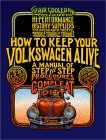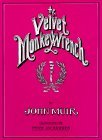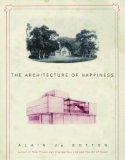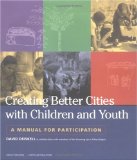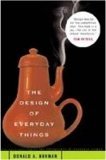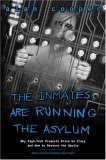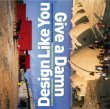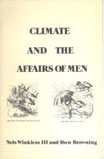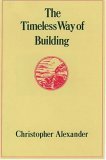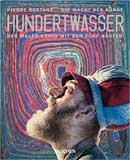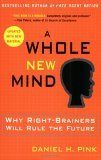Planning and Managing Reliable Urban Water Systems by Robert J. Harberg
This book is full of best practice ideas that no city or people involved in the deployment of water (or any other utility) systems should be without. Considering this subject affects a trillion dollar industry, without which our country would grind to a halt, these simple questions pop to the top of my list “Why isn’t this book on the standard curriculum for engineering colleges everywhere and why isn’t the AWWA promoting it as such and where is the digital web version?” Many thanks Bob for having the dedication to put this needed work together.
How to Keep Your Volkswagen Alive: A Manual of Step by Step Procedures for the Compleat Idiot by John Muir
Technical manuals of any sort seldom deliver, but John Muir’s Volkswagen book for the total idiot stands head and shoulders above anything ever produced. By adding simple metaphors to explain even the most complex subject, John delivers again and again. I have met many people who became auto mechanics and they have all, especially those of the feminine gender, rhapsodized on how this book was the one that really showed them the way. It is often said that this book was the inspiration for the famous Dummies series.
It’s hard to believe that when John Muir wrote this (with the superb graphics by Peter Aschwanden) they had never heard of the web. When you read it, every page seems to dream of migration to digital format in a web page. I used to use this book as an example with senior engineers in nuclear and fossil power plants, to illustrate the true possibilities of what technical manuals could be: clear and concise, with a leavening of subtle humor. Multi-million dollar organizations have tried and tried to emulate Johns work and none have come close. The extended uses of this book are endless, basic introduction to mechanical engineering for an absolute novice, school training, reference guide, and of course, how to keep your beloved VW bug and its relatives running into the next century and beyond.
The Velvet Monkey Wrench by John Muir
So you want to build a new civilization where conflict does not occur and harmony prevails? But what would the rules be, how would it operate — and surely this is an impossible dream. Well, John Muir did not think so and he set out not only to visualize what such a civilization would be like, but to write this superb treatise on exactly how it would happen. “Humankind must learn to progress without contention:” what priceless words. The Velvet Monkey Wrench could really be called “The Guide to a Better Way of Living for Everyone” or “There is Hope for the World,” although it’s real title is the perfect bon mot for today’s sturm und drang world, and would make a perfect third way political statement — shucks, even the tee shirt designs are here.
It’s hard to believe the simplicity of some of his ideas and, again, with superb graphics by Peter Aschwanden. You will not only become a believer but laugh and laugh while you are doing it. Every rule and aspect with metaphorical examples is here. This book should be on the bookshelves of every school in America, as John’s ideas will encourage a whole new generation of thinkers and ,most importantly, inspire hope. Special thanks to Richard Polese of Ocean Tree Books for keeping this great work alive.
Mountains Beyond Mountains by Tracy Kidder
Subtitled The Quest of Dr. Paul Farmer, a Man Who Would Cure the World, this booktells the inspiring story of Paul Farmer, doctor, professor, infectious-disease specialist, anthropologist, the recipient of a MacArthur Foundation “genius” award and a Margaret Mead Award, and founder of the public charity, Partners In Health. With the help of the Gates Foundation, George Soros, the U.N.’s World Health Organization, and others Farmer’s quest to cure the world has taken him from Harvard to Haiti, from Peru to Moscow to Rwanda. One can’t help but see how this one man, if turned loose, could fix the entire healthcare system in America — by doing it right the first time. Warning: reading about this man’s energy will make you very tired!
Pathologies of Power by Paul Farmer
“This book is a physician-anthropologist’s effort to reveal the ways in which the most basic right — the right to survive — is trampled in an age of great affluence, and it argues that the matter should be considered the most pressing one of our times. The drama, the tragedy of the destitute sick concerns not only physicians and scholars who work among the poor but all who profess even a passing interest in human rights. … Pathologies of Power uses case studies to examine the struggle for social and economic rights as they are related to health.” (pg. 6) “To argue that human rights abuses occurring in Haiti, Guatemala or Rwanda are unrelated to our surfeit in the rich world requires that we erase history and turn a blind eye to the pathologies of power that transcend all borders.” (pg. 245)
Veil Politics in Liberal Democratic States by Ajume H. Wingo
Every so often you come across a gem of a book that just keeps getting better with each reading. If only this sort of writing were taught in our schools and colleges. The breadthe of this book is awesome: from Plato’s philosopher king to the Gettysburg address, and on through Machiavelli’s The Prince, then through 911 and what we could do to make the world a better place. Wow!
This type of vision and understanding about America is so sadly lacking in this day and age—and then you find out that the author is a “real” prince from Nso in the northwest province of Cameroon in West Africa and a double “wow” emerges. Americans and westerners regularly put on pseudo masks (what Ajume calls veils) to dissemble and to obfuscate the meaning of this or that, so that you wonder that we are not schizophrenic—and maybe we are. Then we laugh at Africans who put on real masks to openly ascend to a specific role. Ajume’s lesson is more than profound: understand the veil and you will understand the subject matter in a way you never did before; do not, and you are lost on the sea of cold human fog. Great subject and totally readable.
Having met the author over a glorious long session at Starbucks in Boulder, I can tell you he is definitely “the real deal.” He walks and writes tall. Go spend a weekend with this book. It’s got so many things close to your heart that I cannot begin to list them.
The Architecture of Happiness by Alain De Botton
An intellectually brilliant, passionately lyrical extended musing on the significance of architecture to the psychological and emotional health of human beings.
“Belief in the significance of architecture is premised on the notion that we are, for better or for worse, different people in different places — and on the conviction that it is architecture’s task to render vivid to us who we might ideally be” (pg. 13)
“We owe it to the fields that our houses will not be inferiors of the virgin land they have replaced. We owe it to the worms and the trees that the buildings we cover them with will stand as promises of the highest and most intelligent kind of happiness.” (pg. 267)
Creating Better Cities with Children and Youth by David Driskell
This book is a great “how-to” for viewing cities from the perspective of children and young people (my tongue always trips over combining children and youth). For a change, someone actually figured out that although the cultural perspectives of young people who live on different continents differ, the ties that bind them as a generation are stronger than we think, and they could teach “wise” adults a lot. This audience is, after all, a prime candidate for providing perspective because they have not acquired the high tolerance for dysfunction that adults have.
Building on the early work of the late Kevin Lynch of MIT and Chris Alexander, Driskell focuses on design from the people out, not the building or city or state in. Most of our major cities and infrastructure were designed and built in times when command and control was the norm. An elite class dictated “what’s good” and when people’s actions demonstrated resistance to crappy design and construction, laws and codes were created to “control” them, regardless of the negative consequences—which is why laws and codes have nothing to do with Quality of Life. This “Manual for Participation” should be standard coursework for architects, city planners and their ilk at every university. Have you ever wondered what a bird’s eye view of anything has to do with successful human use, or why it is that only French-speaking countries seem to understand that l’ambiance can be felt, measured and created? The icing on the cake is that it’s a readable book at many levels and was brilliantly designed by Dave Driskell’s brother Dean, who truly understands usability, type, and page design.
The Design of Everyday Things by Donald A. Norman
The best logical cognitive design bible in the world is approaching the twentieth anniversary of its second publishing, and it still applies. “The problems illustrated in this book result from a lack of concern and knowledge about how design affects the users of products. … Business and industry have learned that their products ought to be aesthetically pleasing. A large community of designers exists to help improve appearances. But appearances are only part of the story: usability and understandability are more important, for if a product can’t be used easily and safely, how valuable is its attractiveness?” (pg. vi) Despite the many case histories and excellent analyses presented in this book, poor design remains the norm rather than the exception.
The Man Who Listens to Horses by Monty Roberts
Most people can’t even communicate with people: this man, who sees the world in a very different way, learned to communicate across the barriers of species. Monty is achromatopsic: he is unable to distinguish color at all and sees the world only in grayscale. In Pete’s random thoughts on Black and White, he talks about this and other instances of black and white perception and how it opens new lines of communication for the “normally” sighted.
Monty has learned the art of communication with horses (and deer) and then applied those lessons to communications among humans. While this book ostensibly talks about how to work with wild and abused horses, the real message is how understanding, compassion and, above all, respect leads to communication and cooperation, even in the teeth of the most frightful savagery. Monty ends the book with “My goal is to leave the world a better place, for horses and people, than I found it.”
The Inmates Are Running The Asylum by Alan Cooper
Why do 99 percent of technology projects fail? Because no one has considered how the user, how people really use the product. Usability is the answer, and Alan Cooper has spelled out the solution. A classic!
“The theme of this book is that interactive products need to be designed by interaction designers instead of by software engineers.” (p.21) “Computer software is precisely that, soft, and it can be molded into anything that its makers want it to be. They don’t make it easy to use because they don’t know how, not because it can’t be.” This book is about how to make it easy to use, and the process, aptly illustrated with pointed examples from life, is both easy to grasp and easily transferable to any other product.
Envisioning Information by Edmund R. Tufte
You cannot manage what you do not measure, and you cannot measure what you do not see. With most data information systems, the information is in plain sight but no one can see it. To learn from the master how to make it visible, read this book. This beautifully designed tome is a complete course in the graphical display of data of all sorts, presented from the conviction that “the operating moral premise of information design should be that our readers are alert and caring; they may be busy, eager to get on with it, but they are not stupid. Clarity and simplicity are completely opposite simple-mindedness. Disrespect for the audience will leak through, damaging communication.” (p.34) Tufte deftly explores “the essential dilemma of narrative designs — how to reduce the magnificent four-dimensional reality of time and three-space into little marks on paper flatlands,” and provides wonderfully illustrative examples of of how to do it well (and how not to do it).
How Buildings Learn by Stewart Brand
Buildings can be bad, or buildings can be good. This book is also about usability — how the designer considers (or doesn’t) what happens after a building is built. “Loved buildings are the ones that work well, that suit the people in them, and that show their age and history. All it takes is keeping most everything that works, most everything that is enjoyed, much of what doesn’t get in the way, and helping the rest evolve. That goes better if the place is neither owned nor maintained by remote antagonists, because they distance the building from its users. What makes a building learn is its physical connection to the people within.” (pg. 209) Stewart Brand collaborated on a six-part, three-hour, BBC TV series based on this book that aired in 1997.
Design Like You Give A Damn edited by Architecture For Humanity
Designers and architects should have passion, and care about people that use their buildings. Architecture for Humanity was a charitable organization founded to seek architectural and design solutions to humanitarian crises and to provide design services to communities in need. Though Architecture for Humanity closed in 2015, the Open Architecture Collaborative carries on the work. This book is a compendium of innovative projects from around the world that demonstrate the power of design to improve lives. There are more design ideas in here for humanity than in a full library of architectural design.
Climate and Affairs of Men by Nels Winless III and Iben Browning
So you think you know all about global warming? Read this book and get more common sense than anything published today. The authors explore “the proposition that changing climate is the driving force behind human history.” But since they go back to look at cycles that began 250,000 to 5,000 years ago, it’s hard to see how the climate changes charted in this book can be the result of any action taken by men. Instead, the authors show how meteor strikes, earthquakes, tidal forces, volcanoes and sunspots impact the earth’s climate and therefore the history of human civilizations that flee the flood and famine that are the inevitable result of even relatively small shifts in climate.

“Surely You’re Joking, Mr. Feynman!” by Richard P. Feynman
So you want to bring the dropout rate in high schools to zero? Simple: get more teachers who have 10 percent of the passion of Dick Feynman. This collection of stories told by Feynman to Ralph Leighton are as engaging and charming as the man himself. The topics wander from the laboratory Feynman built in his home when he was 11 to a brain-storming session with Niels Bohr, from his first academic tea at Princeton (the source of the title) to receiving the Nobel prize, but the subject is always the unceasing thirst for knowledge and passion for truth that informed Feynman’s own career and that he inspired in his students, punctuated by sharply witty barbs aimed at popping the balloons of pretension, pomposity and fakery.
The Timeless Way Of Building by Christopher Alexander and A Pattern Language by Christopher Alexander et al.
For thousands of years we’ve known that there are patterns that make towns, cities and buildings work or not work. These two books together describe the theory and practice of the “language” of these patterns and present examples of how that language can be expressed. In The Timeless Way of Building, Alexander undertakes to describe the “one timeless way of building” that works. “It is not possible to make great buildings, or great towns, beautiful places, places where you feel yourself, places where you feel alive, except by following this way.” “It is [a process] so powerful and fundamental that with its help you can make any building in the world as beautiful as any place that you have ever seen.” In A Pattern Language, Alexander and his collegues describe one possible language for expressing“the detailed patterns for towns and neighborhoods, houses, gardens, and rooms.” The two books together give theory and practical examples of an entirely different way of looking at the spaces humans build for themselves.
Hundertwasser: The Painter-King with the Five Skins by Pierre Restany
Man is the only creature on earth who creates structures with rigidly straight lines and lives miserable lives inside those structures as a result. Nature uses fractals and pattern logic, an approach through which she has survived very successfully for millennia. Bio-mimicry is the art of comprehending and using nature’s approach to building. Perhaps only one Architect in the world has ever successfully demonstrated how this can be done, the late great Friedensreich Regentag Dunkelbunt Hundertwasser. All his work fascinates me. Restany’s book is a comprehensive primer on Hudertwasser’s work and the guiding philosophies behind it.
A Whole New Mind by Daniel H. Pink
Why we need more conceptual designers and artists and fewer engineers in the new information age. Most engineers see with the left side of their brains, which means they can’t grasp concepts (which come from the right side). Throw out your calculus and start sketching!
“This book describes a seismic — though as yet undetected — shift now under way in much of the advanced world. We are moving from an economy and a society built on the logical, linear, computerlike capabilities of the Information Age to an economy and a society built on the inventive, empathic, big-picture capabilities of what’s rising in its place, the Conceptual Age.” (pg. 1)
The Holographic Universe by Michael Talbot
So you think you understand the universe you live in? Read this book and you will be introduced to an entirely different one. Talbot pulls together concepts from the work of acknowledged scientific experts He quotes physicians, psychologists, physicists, neurophysiologists, engineers, NASA researchers, biologists and others, as well as poets, mystics, shamans, psychics and clairvoyants, “to suggest that our world and everything in it — from snowflakes to maple trees to falling stars and spinning electrons — are also only ghostly images, projections from a level of reality so beyond our own it is literally beyond space and time.”
A New Kind of Science by Stephen Wolfram
Everything that man builds falls apart; everything that nature builds endures. Wolfram shows how science can be approached just like nature, and demonstrates the approach by showing how to grow software patterns for infinity. In simple language that can be followed by any moderately educated layman, he outlines “quite universal principles that determine overall behavior and that can be expected to apply not only to simple programs but also to systems throughout the natural world and elsewhere (pg. 4).”
At the end of 846 pages of lucidly written text, easily followed logic, and apt illustrations, Wolfram concludes that “the Principle of Computational Equivalence encapsulates both the ultimate power and the ultimate weakness of science. For it implies that all the wonders of our universe can in effect be captured by simple rules, yet it shows that there can be no way to know all the consequences of these rules, except in effect just to watch and see how they unfold.” Warning: this book is not for the faint of heart — with the notes, it totals a daunting 1197 pages!


